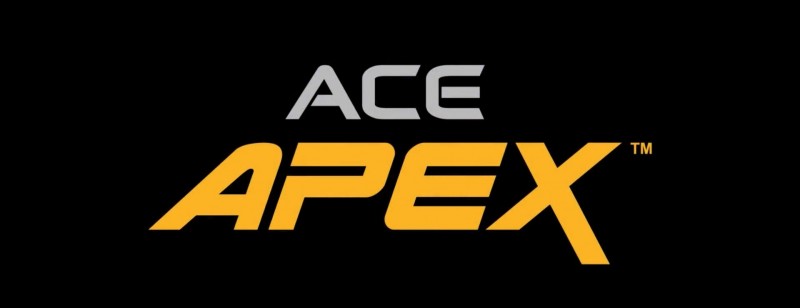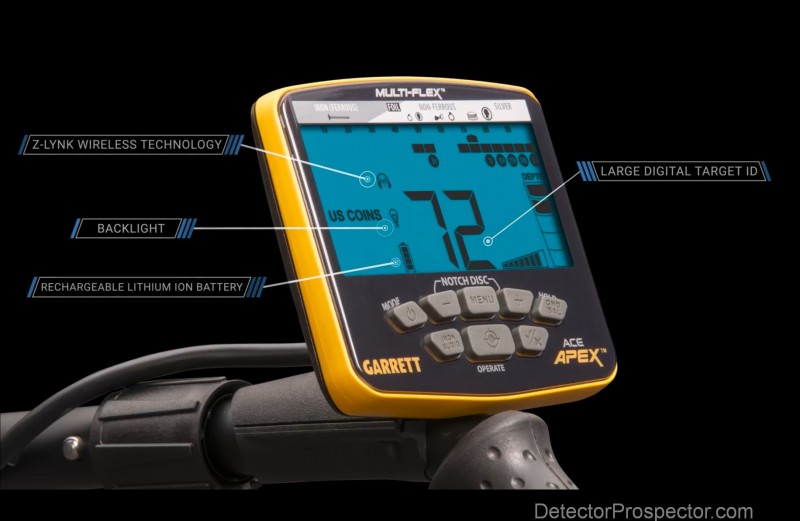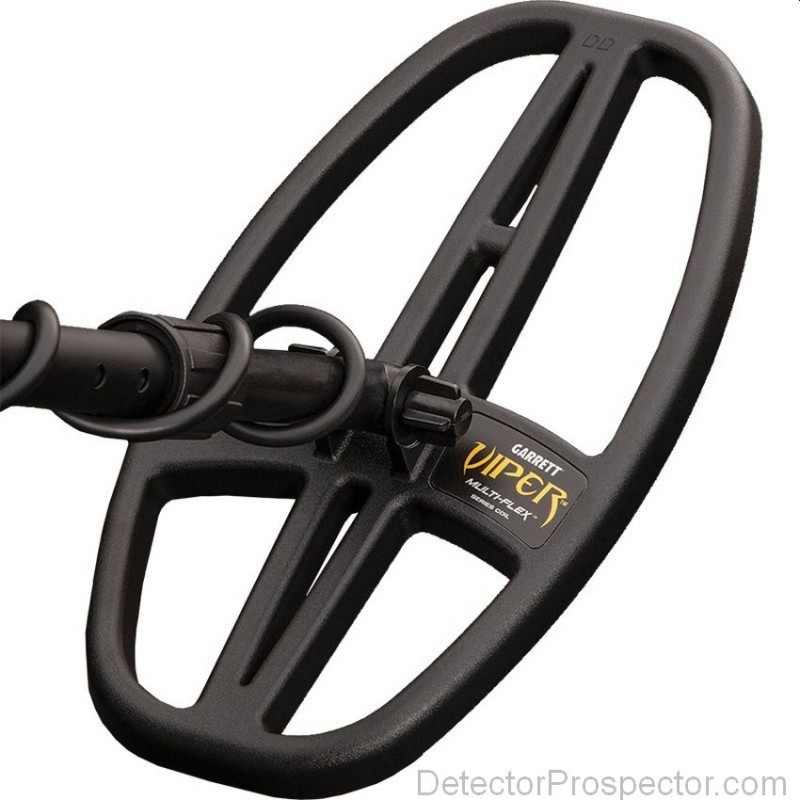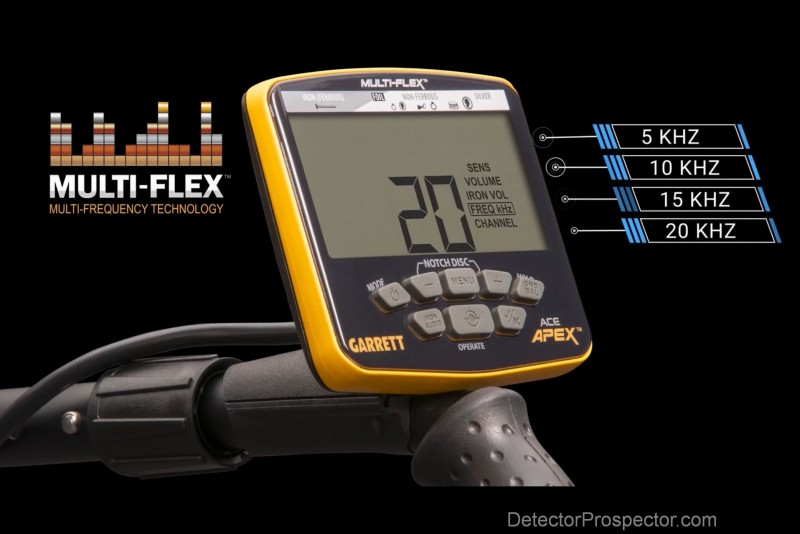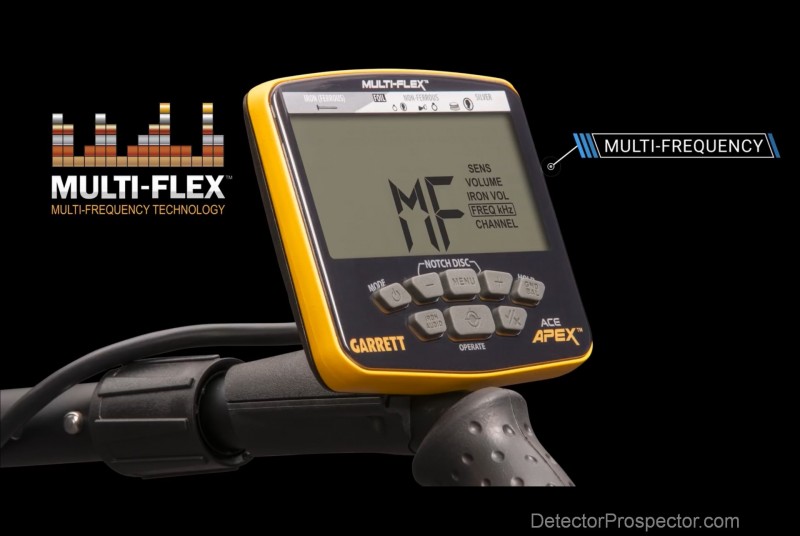-
Posts
6,119 -
Joined
-
Last visited
Content Type
Forums
Detector Prospector Home
Detector Database
Downloads
Everything posted by Chase Goldman
-

Garrett Apex Revealed - It’s Multifrequency!
Chase Goldman replied to coinhunterseth's topic in Garrett Metal Detectors
When the CEO said - I should reveal that the full name is the "Ace Apex" my shoulders slumped. Then they just killed it with the MF announcement. Great job Garrett. Charles would be proud. Garrett Ace Apex logo -

Garrett Apex Revealed - It’s Multifrequency!
Chase Goldman replied to coinhunterseth's topic in Garrett Metal Detectors
Instant take on the Garrett Apex: Pros Multi Freq (2 MF modes - Land and Salt) 4 Multiple Single Freq 5 - 20 khz (perhaps a viable gold machine) Light weight (2.5 lbs with stock coil) Good Display/Large Numerical and coin type target ID/sleek housing Multiple Search Modes 8 level sensitivity setting Ground Balance Variable iron audio Wireless Rechargeable battery Depth Meter Cons Not submersible but rainproof Limited coil selection initially Yet another proprietary wireless technology to deal with. 5 tones only without adjustable tone breaks (I think) No true all metal or threshold adjustment Limited Disc/Notch segments vs. target ID range (20 notch segments, including 8 ferrous segments for 1-99 TID) Modes don't appear to have recovery speed variations unlike Simplex and Vanquish. We'll see Future Accessory Coil selection (and will 3rd parties be in the mix, unlike ML's latest offerings, will concentric/coaxial coils/solid coils be offered?) Actual retail pricing - not bad if it comes to pass as announced (i.e., mid $400's without Lynx Phones to just <$500 with wireless phones). How good does their MF actually perform (it's not automatically good just because it is MF and this is Garrett's first iteration vs. Multi IQ being effectively ML's 4th generation MF iteration) What is the actual recovery speed compared to fast detectors like the Equinox and Deus? How good is the target ID stability, repeatability, and does it vary depending on frequency selected? How well does it deal with EMI susceptibility? Will it be software updateable? Conclusion: They hit the sweet spot that Vanquish missed. Between the capable Nokta Simplex at $330 with wireless and $150 less than the waterproof 600 but with wireless phones included and additional single frequency options. Vanquish missed out because no single freq included, also only rainproof, and has a fixed GB so if you compare the Vanquish 540 Pro Pack vs. Apex with wireless phones option you are trading off some added functionality in terms of modes, frequency selections, and ground balance in the case of the Apex vs. an extra coil with the Vanquish 540 PP (IMO - Garrett wins that one because you can always buy another accessory coil, but you can't buy a feature set upgrade). It is a worthy competitor to Vanquish and will compete well with the Equinox 600 and should sell well. Not to mention it has undercut from a price standpoint every multi-selectable single frequency machine out there (Equinox 600/800, Multi Kruzer, Amphibio, Orx, Impact, Tarsacci, Whites V series, and Deus). I am pleased that Garrett is moving forward with Multi. They beat Nokta to it and I never saw that coming. Garrett Ace Apex detector; backlight, rechargeable, wireless -
They only have one compatible coil so far. "Fully waterproof, the Viper is a blend of two of Garrett’s most popular DD coils. The 11" size is large enough to cover plowed fields, but its narrow 6" footprint allows easy separation of targets in iron-infested areas. The Viper is designed as a low-impedance, broad-bandwidth coil to support the new Apex Multi-Flex frequency technology. Note: As a result of the Multi-Flex coil technology, the Apex Viper coil is not compatible with older ACE detectors. Prior ACE coils are not compatible with an Apex detector." Garrett Ace Apex Data & Reviews Garrett Viper 6" x 11" Multiflex search coil for Ace Apex metal detector
-

Garrett Apex Revealed - It’s Multifrequency!
Chase Goldman replied to coinhunterseth's topic in Garrett Metal Detectors
And single frequency selectable -- Take That Vanquish! Garrett Ace Apex selectable frequency metal detector -

Garrett Apex Revealed - It’s Multifrequency!
Chase Goldman replied to coinhunterseth's topic in Garrett Metal Detectors
Welp they knocked it out of the park - It IS a multifrequency machine! Garrett Ace Apex multifrequency metal detector -

So May 15th Is The Date --- Garrett Apex
Chase Goldman replied to Sven1's topic in Garrett Metal Detectors
BTW It's an 11am EDT live stream viewing event you need to pre-register for as a ploy to get your email into their market database. Good stuff. Hope it is as riveting as the hyped-up live stream of the CEO's announcement a few weeks back of a coming announcement (I kid you not). That was awesome. -

So May 15th Is The Date --- Garrett Apex
Chase Goldman replied to Sven1's topic in Garrett Metal Detectors
Something that Minelab can't seem to bring itself to do. Their wireless modules are frustratingly, purposefully made to be non-compatible across detector lines even though inside each one of those non-compatible modules is the same proprietary Wi-Stream wireless technology. Nuts. Glad Garrett didn't make the same mistake with Z-Lynk. -

So May 15th Is The Date --- Garrett Apex
Chase Goldman replied to Sven1's topic in Garrett Metal Detectors
Only generates enough electricity power a watch, though. Besides, Garrett hasn't even used rechargeable batteries yet (until perhaps the Apex) so I seriously doubt they are on the cutting edge of power technology, to say nothing of detector technology. -
Where do I go to lodge a complaint then. This is unacceptable!
-
Chuck, C'mon, you're never to old to be cute, especially when it comes to trying to get Dilek's attention so you can get her to announce that Nokta multi whamabang detector you have been waiting for so anxiously. And you know as well as I do that Steve isn't going to remove a post just because someone thinks it is confusing, otherwise I wouldn't have any posts left on this forum. Wasn't asking you to correct anything either. At least not for my sake. But you were the one who asked me to point out what I thought was confusing, so I did. Otherwise, I would have just left well enough alone. Like I said, no biggie. Cheers.
-
Um, ok. Here you go. I know you were trying to be cute, but I found that confusing (I did have to read it more than once) regardless of how much you want to tell me and kac to go back and reread it and want to point out how you didn't say this and that. I don't want to reread it again because it is giving me a headache Anyway, sometimes you just gotta listen to your audience and own it. But that's up to you. No biggie as far as I'm concerned. Hope Dilek makes your dreams come true with that new Nokta detector sooner than later, Chuck.
-
Glad I wasn't the only one completely confused by Chuck's post.
-

Sens Setting For Deep Coin Squeakers…
Chase Goldman replied to Happa54's topic in Minelab Equinox Forum
There are a mixture of things going on here. I am not an FBS expert, but I know enough to be dangerous based on limited swing time with a CTX and sitting in on Andy Sabisch's FBS bootcamp presentation (in other words: I know what I don't kinow about FBS/FBS2 detectors). The FBS and Multi IQ multifrequency processes are fundamentally different so that makes it difficult (impossible?) to do an apple to apple comparison based on settings alone. I am not going to go into this in too much depth but it is discussed at a high level in the Minelab Multi IQ tutorial series that was put out during the Equinox initial release and was consolidated by Steve H. here: https://www.detectorprospector.com/metal-detecting/minelab-multi-iq-technology-details-explained.htm There is a great rackout of BBS/FBS Machines vs. Equinox by Steve H.here: Both of the above links are contained in Steve's excellent Minelab Equinox Essential Information thread. Regarding the FBS machines, they have very sophisticated discrimination implementation and an AUTO sensitivity setting (which I know very little about). You can discriminate on both conductivity and "ferrous" ID on a 2-dimensional basis. FBS is very computationally intensive as far as signal processing is concerned. That combined with likely a slower processor (vs. Equinox) make for a lower recovery speed vs. Equinox and also FBS/FBS2 is weighted towards lower frequencies/higher conductors (and correspondingly weaker on gold) vs. Multi IQ which is comparatively more balanced overall (even when considering the Multi IQ low frequency weighted modes) and also, unlike FBS, multiple Multi IQ profiles exist on Equinox to enable Equinox to be set up to favor different target conductivity ranges (high vs. mid conductors and gold) and environments (park with modern/aluminum junk vs. field with iron junk vs. beach). All this being said, I am somewhat skeptical on what your silver slayer friends are saying about lowering sensitivity to get maximum depth by keeping shallower targets from overloading their machines because it sounds like something that one NEVER gets in metal detecting - "the free lunch". Metal detecting is all about trade offs. You can filter out iron with disc or iron bias but you risk missing low conductive keepers or masked higher conductors. You can notch out pull tabs because you are hunting around a common bonfire area, so you risk not finding that gold ring, but clean up on silver and clad.I have often lowered sensitivity in thick iron situations, to enable me to "see" or "sift" for shallower keepers that would otherwise be masked by strong iron signals (deep or shallow) overloading the coil. Notice that I said, "shallower keepers" because I am willing to trade depth to recover masked keepers that have been sitting there for decades because they were missed by slower detectors that wouldn't stand a chance under those conditions regardless of their sensitivity setting. I have never heard of maximizing depth by lowering sensitivity, alone. Although they are recovering high conductors at significant depths with these lower sensitivity settings, I suspect that perhaps there is significant sensitivity headroom available on the CTX/eTrac vs.the Equinox. Note that if the setting ranges were perfectly linear and scaled equivalently between the machines, then an 18 on a CTX would be equivalent to a 15 on Equinox. Not a setting I would use for max depth. Note also On the CTX the default manual sensitivity setting is 22 which would be the equivalent of 18 on the Equinox (not the same as the Equinox's 20 default setting) so that lends more credence to the "increased sensitivity headroom" vs. Equinox argument. At the very least, you can see that comparing the sensitivity settings between the two machines to be a tricky proposition at best. For max depth I would set the Equinox up on the highest stable setting (i.e., one notch below where noise affects a neutral coil). Equinox is all about maximizing signal to noise ratio. Settings that maximize the signal to the extent practical without raising the noise floor - sensitivity increases the signal to a point, but with too much sensitivity you introduce instability in the form of random signal noise. I start with the default and move it up or down from there. You can further reduce noise (which is not just EMI but also ground noise and junk target "noise") by obviously running a NOISE CANCEL which I do before I set sensitivity (noise cancel appears to be done at a preset normalized sensitivity setting that is independent of the sensitivity setting of the machine, so you don't need to set your sensitivity to "max" to do a noise cancel); doing the appropriate ground balance, setting sensitivity "on the edge" unless I am "sifting" through junk (as described above), the setting the appropriate recovery speed (lower recovery speeds can result in more ground noise) and iron bias as desired. I don't use notches and prefer to run with the default disc setups or run with the horseshoe button eliminating all disc. All of this is a very long winded way of saying 1) that they may be getting maximum depth for the site conditions, but their ultimate depth could be greater in a situation where the they could run with a higher sensitivity and 2) their default sensitivity setting is lower compared Equinox so even though a setting of 18 seems like they would be hunting with a 16 sensitivity on Equinox all things being equal - the fact is all things are not equal because their default sensitivity setting is lower on the scale vs. the Equinox default setting (i.e., the "22" default on CTX "appears" to be a equivalent to an 18 setting on the Equinox scale, yet the Equinox uses an actual default of 20). I would take what your silver slayer friends are saying with a grain of salt and recognize that what they are doing doesn't necessarily translate directly to the Equinox. It is dangerous enough to simply use someone else's favorite settings on Equinox without a basic understanding of what the settings do (a typical newbie mistake). Being experienced with the Equinox you are not subject to that issue, but things get even more dicey when you try to translate settings from another model detector to your machine even if they are both Minelab multi frequency detectors because that is about where the similarity ends. -
Nice silver and mid-20th century military relics. Looks like you are getting the hang of the new machine with that great sniper coil.
-
Thanks for the drive by, hope it worked out...
-
Yep. I believe XP never pursued FCC certification for the analog machines so they are not sold in the US.
-
I just knew my 40-45 minute statement was going to get a response, but rest assured, I am not !! I know you're not crazy because apparently you spent a lot more time swinging it than 40-45 min in a ghost town. So that makes a for a completely different story. In the ghost town scenario, I would probably use my Deus over the Equinox. I'm still evaluating the Vanquish, but one annoying thing I have come across is that it apparently has an affinity for constently ringing up pull tabs in my local park at 18 (in jewelry mode). Why is that a problem? Because it pushes the typical pull tab at that site into the high 5-tone bin on the Vanquish and the breakpoints are not adjustable. It bangs hard on actual high conductors though, but it is annoying constantly stopping in my tracks by a great souding ringing high tone and staring down at that 18 on on the VDI. Boo!
-
At least you gave it a thorough run through, Monte.
-
Alain Loubet - the founder and CEO of XP was a big fan of Tesoro detectors and the analog audio. The story goes that when Alain suggested some modifications to improve on his design to Jack Gifford of Tesoro, Jack kindly told him what he could do with his suggestions. That inspired Alain to build his own analog audio ID detector, the Adventis around 2000 which had a very familiar Tesoro look and feel. After some iterations on that concept, Alain embarked on a groundbreaking wireless design that became the Deus and it's simplified but similar performing cousin, the ORX. While the Deus and ORX do have digital target ID displays, they are also primarily about the audio and borrow their audio target ID from XP's earlier analog offerings. Full tones, pitch tones, and Gold Field's VCO pitch like audio convey a lot of subtle target information their audio and the visual target ID just provides an additional piece of the puzzle. Most relic hunters in the UK that use the Deus often hunt purely by audio and leave the control unit that displays target ID information (and helps to custom program their machines) in the car during the hunt relying solely on the wireless headphone audio to make dig decisions. You could say that the Deus audio has a little Tesoro DNA included in it's design.
-
That's exactly why I place little stock in nailboard tests as conclusive indicators of relative, real-world detector performance because they are unrealistic 2-D setups. Whereas the relative adjacent target depth aspect of real world 3-D target distribution in the ground changes the equation significantly as your simple demonstration illustrates.That being said, I find El Nino's test results interesting from a pure intellectual curiosity standpoint.
-
I guess I would call that Steve's "golden rule"
-
Yes. I would use 28Khz for gold/gold jewelry. You can push it to the higher frequency (54 khz) for micro gold but your depth will suffer a little.
-

Question On Simplex + Update 2.76 And 2.77
Chase Goldman replied to Ridge Runner's topic in Nokta / Makro Metal Detectors
Yes, 2.77 includes the 2.76 changes. -
Just a couple of considerations for those using the ORX. The Deus Hot program utilized in the video uses full tones which gives some of the telltale tonal nuances heard in the video. Unfortunately, it is not available on the Orx which is limited to 3 tones, but some of the principles still apply (e.g., TID variability). Note also that he was using an HF coil at 14 khz. On Deus, the HF coil target ID's are not normalized. On ORX, the HF coil target ID's are all normalized to 18 khz equivalent target IDs so the Target IDs in the video will not correspond to the target IDs you will see even if running the HF coil at 14 khz on the ORX.
-

First Day Out With The Vanquish 440
Chase Goldman replied to Bash's topic in Metal Detecting For Coins & Relics
There is nothing subtle about it when it bangs on a high conductor, believe me. Newbs would do better with it than the Simplex from an audio, target ID, and user interface perspective. Hope to get some video up soon to show what I am talking about. It does have audio nuances the experienced detectorist can take advantage of (just like any late model ML detector) but that doesn't in any way hinder usability by beginners. [BTW - that is no bash on the Simplex. The Simplex has intermediate level features at a beginner price point - in other words an outstanding value detector with some advanced capabilities that were left out of the Vanquish (e.g., waterproof, ground balance adjustments and a threshold-based all metal mode) which are great for the intermediate to advanced detectorist. I think the Vanquish just sets up better for someone just getting into the hobby as a turn on and go detector with limited settings that someone would be hard pressed to screw up in a manner that would really hinder their detecting. Contrast that with the Simplex which actually has a bit of a learning curve (not surprisingly considering the features Nokta packed into it) including some modes such as threshold-based all metal, that beginning users would find difficulty in setting up properly.]


